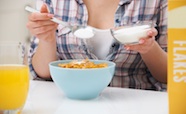Professor Jim Mann's personal mission is for people to know how much sugar they are having, because right now they don't.
Food labelling is difficult to understand and often misleading. Whether you aim to have no more than 5% (about 25g or six teaspoons) or the currently recommended 10% (around 50g or 12 teaspoons) of your daily calories from sugar, you need to be aware of the hidden sugars in manufactured food.
Sugar is hard to avoid
In ingredients lists look for sugar and its aliases: brown sugar, fructose and crystalline fructose, high-fructose corn syrup, invert sugar, rice/corn/maple/malt/golden/palm syrup, corn sweetener, maltose, sucrose, glucose, molasses, syrup, dextrose, honey and raw sugar.
Check the nutrition label for sugar percentage and amount per serving, although serving sizes can be misleading. Professor Mann came across a yoghurt drink recently that had a Heart Foundation tick. Checking the small print on the back showed the package contained three servings and at that quantity the amount of sugar would not be too bad per serving. However, the servings were very small, even a child would drink the whole pack and that would be your 10% of sugar in one drink, he said.
Sneaky sugar
- A product labelled ''low fat'' often means it has been bulked out with sugar—read the nutrition label carefully.
- Cakes, biscuits and even ''healthy'' oatmeal and muesli bars often contain 25%-35% or more sugar.
- ''Lite'' or reduced sugar products are appearing on supermarket shelves. Check the ingredients and nutrition labels.
Drinks
- The average can of soft drink contains about 35g of sugar, about 9 tsp. Avoid soft drinks and energy drinks.
- Drinking chocolate can contain about 6 tsp of sugar per serve. Use cocoa, sweeten it yourself.
- The best drinks to have are either milk or water.
Bread and breakfast
- Many breads, including the healthier wholegrain ones, contain 3%-4% sugar. Read the labels carefully and if you think this is too much, make your own bread.
- Breakfast cereals can contain up to 38% sugar; many, even those promoted as healthy, can contain about 18% sugar: a bowl of breakfast cereal may contain about 14g of sugar. Switch to a lower sugar one or make porridge and add your own sugar if needed.
- Sweetened yoghurt, flavoured milk and other dairy products usually have high amounts of sugar. Choose a plain, unsweetened one and stir in your own fruit.
Lay off the sauce
- Tomato sauces, BBQ sauces, relishes and chutneys can contain between 25% and 39% sugar—a tablespoon of ketchup can contain 7g.
- Canned baked beans and spaghetti can contain about 5% or 6% sugar.
- Many ready-made pasta sauces, soups and canned products contain 3%-4% sugar.
Reducing sugar in cooking
You can often reduce sugar in cooking. It's rarely needed in main courses, vegetables, breakfast dishes or snacks. Most fruit is naturally sweet and doesn't need much, if any, added sugar.
When making jam, instead of the traditional proportion of 1kg sugar to 1kg of fruit, Professor Mann recommends using 600g of preserving sugar, which has added pectin, to 1kg fruit. Boysenberry jam made this way is delicious, he says.
Experimental baking
In baking, sugar affects volume, moisture, texture and colour of cakes and biscuits as well as adding sweetness. However, many recipes have more sugar than necessary and too much sugar can obscure the flavour of other ingredients, such as chocolate.
Some people say you can reduce the sugar in most recipes by a quarter or even half without much noticeable difference. You can use a mashed ripe banana, fruit puree or dried fruit instead of some of the sugar, although this might affect the texture. Sweet spices such as vanilla, cinnamon, nutmeg, mint and angelica, or orange or lemon zest can intensify the flavour.
Experiment! Your cake or biscuits might not be quite the same but that's not necessarily a bad thing.
Download this page:
Tips to reduce sugar (PDF 335KB)

Special thank you to ODT
Thank you to the Otago Daily Times for their permission to use material from their interview with Jim Mann by Charmian Smith. Read the full article:
A taste for the refined 4 June 2014, Otago Daily Times' website